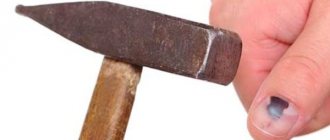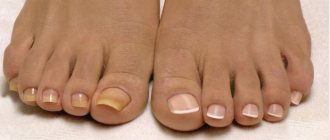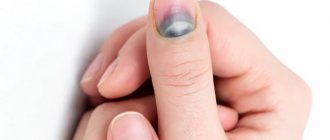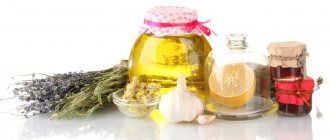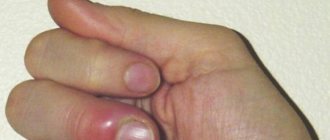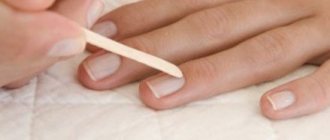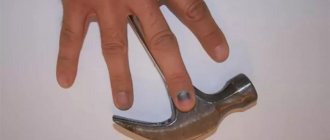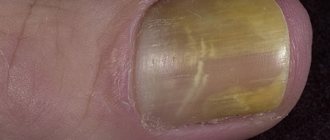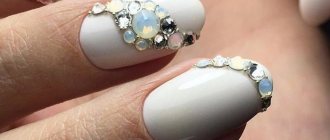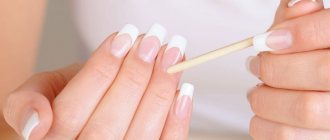Causes of an abscess on the foot near the nail
The inflammatory process near the nail begins when pathogenic bacteria enter the skin as a result of an injury or microtrauma. First, the finger begins to turn red and painful sensations appear. Then the process progresses to the purulent stage - a subcutaneous blister forms in the area of infection, filling with pus.
The reasons for the development of this condition may lie in the following factors:
- Ingrown toenail.
Hit by a splinter. - Scratches, cuts.
- Incorrectly performed pedicure causing injury.
- Cracks in dry skin.
- A broken hangnail.
- Ingrown toenail (see photo for its schematic representation).
So, any injury can lead to an inflammatory process if it is not immediately treated with antiseptics. The condition can be aggravated by:
- Reduced immunity.
- Presence of diabetes mellitus.
- Fungal infection.
- Severe blood diseases.
- Problems with natural metabolism.
- Lack of vitamins and nutrients.
Treatment must be started early to prevent the condition from getting worse. Otherwise, the inflammation may spread further throughout the leg and cause sepsis.
Getting a nail injury
Regardless of the cause of the injury, the process in the area near the nail proceeds the same:
- Impact, other damage;
- Rupture of blood vessels, disruption of nerve endings;
- Formation of bruising, disruption of metabolic processes;
- Change in color of the nail plate and the area nearby;
- Dying of the nail;
- Growth of a new plate.
If the injury is severe, the color of the damaged area changes immediately, and pain is felt constantly. The finger swells, turns red, and hurts. If the swelling extends to the foot, there is a possibility of damage to the phalanx.
The traumatologist will prescribe treatment that relieves pain and accelerates the regeneration of the nail plate. Due to the unprotected matrix under the nail, the area nearby hurts. Bandages, anti-inflammatory and painkillers are prescribed to alleviate the condition.
Fingertips
Often the area around the toenail hurts due to an ingrown toenail. There are a lot of factors that provoke the appearance:
- Failure to follow the pedicure technique, the corners of the nail are processed incorrectly;
- Wearing shoes with pointed toes that put pressure on the toe areas near the nails;
- Abnormal foot position due to flat feet;
- Swelling, excess weight;
- Fungal infections of the feet.
Popular treatment options:
- Treatment with a laser beam of the skin on the toes around the nail;
- Exposure to radio waves;
- Complete removal of the damaged nail.
You can cope with the pathology at home, using folk remedies and conservative treatment. Measures:
- Changing shoes to comfortable ones;
- The use of antibacterial, antifungal drugs;
- Keeping your feet clean;
- Professional pedicure.
Professional pedicure
By constantly following the rules, the likelihood of pathology occurring near the toenails is minimized.
When to see a doctor
If, after two days from the start of treatment, the inflammation has not eased, and your finger still breaks out, you need to consult a doctor in a trauma room. You will be prescribed therapy and may be prescribed a course of antibiotics. You will need to follow your doctor's instructions strictly.
In some cases, surgery may be required. The doctor will open the purulent blister near the nail and remove the pus from there. A bandage will then be applied. This is required only in cases where it is no longer possible to cope with inflammation and abscess in other ways.
Treatment for an abscess on a finger
If your toe is inflamed near the nail, you need to start treatment with first aid. For this:
- Dilute several crystals of potassium permanganate in warm water. Immerse your finger there for 10 minutes. After 2 hours, take another bath.
- Instead of potassium permanganate, you can use a decoction of chamomile. Cool to a comfortable temperature, also lower for 10 minutes, repeat after 2 hours.
- To draw out the pus, apply a cut aloe leaf and secure it with a bandage or plaster.
Further treatment is carried out using medications. Traditional recipes can also be used to relieve inflammation and accelerate natural regeneration.
Drug therapy
Treatment at home necessarily involves constant treatment of the inflamed area with antiseptics. It can be:
- Dioxidine. 1% solution or dioxidine ointment.
- Miramistin. Solution 0.01%.
- Levomekol. Ointment with antiseptic and anti-inflammatory effects.
- Furagel, furatsilin.
- Vishnevsky ointment.
When using ointments and solutions to relieve inflammation and destroy pathogenic microbes, pus matures much faster. You cannot remove the purulent element on your own ; there is a chance that you will simply worsen the infection.
If the inflammatory process began due to a fungal disease, specialists may prescribe external agents such as:
- Lamisil.
- Thermikon.
- Exoderil and others.
When choosing medications, you must follow the doctor’s recommendations, and not choose what to treat on your own. Specialists can also prescribe antibiotics for therapy, and not just anti-inflammatory drugs. But for any prescriptions, doctors need to understand what caused the inflammatory process near the toenail.
Antibiotics that may be prescribed:
- Tetracycline. An ointment containing an antibiotic.
- Erythromycin ointment. Used if soft tissues are infected.
- Synthomycin liniment. Local antimicrobial agent containing chloramphenicol.
If drug treatment is impossible or ineffective, surgical therapy is prescribed to remove dead tissue and prevent re-infection.
Folk remedies
An alternative option for treating an abscess near the nail at home is the use of folk recipes. They are based on the use of natural antiseptics and anti-inflammatory drugs that help accelerate suppuration. Recommended at the initial stage of inflammation, not suitable for full treatment of serious paronychia.
If your toe is breaking out, you can try the following homemade recipes:
- Dilute a tablespoon of baking soda and salt in a glass of water. Immerse your foot in this solution for 10 minutes. Do it three times a day.
- Bake a small onion in the oven. Crush it (or puree it in a blender). Apply to the affected area and secure with a tight gauze bandage. Keep it on for 4 hours, then change the bandage to a new one.
- Apply aloe pulp and secure with a compress. Change every 4 hours. This helps to quickly draw pus from the wound and also relieve pain.
- Dilute a small pinch of copper sulfate in 100 grams of warm water. Immerse for 5 minutes. Take a bath four times a day. This helps relieve puffiness and remove swelling.
- Grate the beets, onions and carrots, mix into one common paste. Apply a sterile bandage to your finger and leave it on overnight.
- Pick a coltsfoot or plantain leaf. Clean, rinse. Apply to the affected area and secure as a compress. You can keep it for 12 hours (it’s enough to leave it overnight).
Experts recommend not only using compresses from folk remedies, but also alternating them with the application of anti-inflammatory ointments. This way you will achieve the desired effect much faster.
Why does the nail on the big toe peel?
Detachment of the nail on the big toe is a common occurrence and, unfortunately, not always only a cosmetic defect, but it can also be effectively dealt with. Onycholysis, as this process is called in medicine, can sometimes be very insidious, and it is better to start treatment immediately. Otherwise, over time, no varnish will be able to hide this defect: onycholysis leads to the complete loss of the nail plate.
Onycholysis is not only scary visually, it is also dangerous because various microorganisms collect there. This is a pathogenic zone where moisture, epidermis and bacteria collect,” says podiatrist Marina Khrushch.
How does detachment work?
There are plenty of signs and accompanying symptoms of onycholysis, and this may not only be direct detachment of the nail.
The process is accompanied by:
- The appearance of an empty air gap under the nail
- Thickening of the nail plate in children
- The nail bed becomes inflamed
- Bleeding
- Aching and twitching pain in the area of the affected nail, sometimes the pain is very strong
- Plate thickening
- Yellowness
- Edema, finger becomes swollen
- Severe pain when pressing
- Looseness, softness of the nail plate, it literally crumbles
- The nail “comes off” from the toe (this can happen perpendicular to the growth of the plate (onysoschisis), parallel (kaylonchinia) and even next to the cuticle (onychomadesis), if there is very severe inflammation)
A healthy nail does not suddenly come off on its own; often this disease develops in stages:
- Feeling of dryness and itching on the skin of the foot, it can also peel off greatly
- The appearance of inflated blisters with fluid on the foot, resembling calluses
- The nail plate changes qualitatively: it becomes very hard, but at the same time it is brittle
- The appearance of that same air layer under the nail
- The nail peels off, turns noticeably yellow, and whitish spots may form.
- The nail falls off
This process is extremely unpleasant and may be accompanied by painful sensations. Under no circumstances should you delay the treatment of this disease. The sooner treatment begins, the greater the chance of restoring the damaged nail.
Why on your feet?
Toenails are the most at risk as they suffer from shoes that are too tight, are more likely to be injured and are vulnerable to fungus, which can easily become infected.
The disease can be caught in a public pool, on the beach, in the gym, sauna, bathhouse, and even from the shoes of a family member who suffers from a fungal infection. Therefore, it is very important that such a family member has individual items for exclusively personal use: his own soap, socks, towel, stockings, tights and, of course, shoes.
Possible reasons
It’s worth mentioning right away that the cause of nail peeling can be not only a serious and terrible disease, but also simply external factors.
Here are the most common reasons why toenails peel:
- Injuries, bruises, compression, any rough mechanical impact (does not pose a great danger, the nail will come off on its own)
- Tight, ill-fitting and ill-fitting shoes
- Toe nail extensions done poorly and incorrectly
- Diseases associated with the endocrine system (sometimes peeling of nails)
- Severe allergic reactions
- Long-term aggressive chemical exposure
- Effect of too high or too low temperatures
- Long-term use of certain types of antibiotics (fluoroquinolone, tetracycline series) and hormonal drugs
- Compression of the limb and decreased blood flow
- Infection
- Mycoses
- Skin diseases: psoriasis, eczema, dermatitis
- Disorders in the nervous and endocrine systems
- Fungal diseases and pus under the nails
If noticeable pain is felt, this indicates the following factors:
- Infectious diseases (as a rule, not only one toe hurts, but the entire foot)
- Specific diseases
- Mycoses (onychomycosis, rubromycosis, candidiasis, panaritium and others)
- Pain can also be felt after injury (mechanical damage and ingrown nails)
Necessary treatment
First aid
If the nail leaves the finger right now, and the reason for this is damage due to injury, then the following measures must be taken. Otherwise, infection will occur.
- It is necessary to cool the damaged area - apply ice
- Wrap your finger in a bandage and tighten the affected area, but not too much
- Use kombucha tincture, it will relieve swelling
- Make a compress from vinegar (apple vinegar) and any vegetable oil (olive oil is suitable)
You can try to remove the peeling plate yourself, but use extreme caution when doing so.
- Wipe the scissors with a disinfectant solution and cut off the part that flakes
- Treat the affected area with iodine, chlorhexidine or hydrogen peroxide
- Prepare a foot bath. Mix sea salt with tea tree essential oil in clean water and pour it into any container. It is recommended to keep your foot in this mixture for about half an hour.
- Use a regenerating and healing gel or cream (Regetsin, Bepanten)
Use baths daily to protect yourself from infections and contaminations. If you suspect that your finger has been injured due to chemicals, you should immediately stop using them, as the situation may only get worse.
Professional treatment
If you discover any problems with your nails, you need to contact (as early as possible) a dermatologist, who will prescribe competent treatment and prescribe medications and medicines. Only an experienced specialist knows for sure how to treat and with what to treat.
If all the necessary tests have been passed, the dermatologist may prescribe antimycotics (usually Fluconazole, Ketoconazole, Griseofulvin, Intraconazole). Before using them, the nail is completely removed, and the use of these products is carried out only under the supervision of a doctor. The course often takes from 3-4 months to a year. The plate that begins to grow is carefully removed.
In parallel with this, you will have to boil all the hosiery and apply an antifungal agent to the shoes (these include Formidron, Chlorhexidine, Miramistin). Only clean shoes are processed. You will also have to arrange regular baths. Cosmetic varnishes cannot be used in this case.
The doctor can also prescribe a course of multivitamin complexes, the course lasts at least six months.
The treatment will not end and after complete restoration of the nail, the prescribed ointments will need to be rubbed in. This is done in order to prevent the development of dermatitis and eczema.
If the nail turns yellow and begins to peel, the cause should also be sought in the hormonal background. In this case, it is worth visiting an endocrinologist who will identify the disease (thyroid problems, metabolic problems).
Additional treatment and prevention
- Use only comfortable shoes that fit you
- Treat yourself conscientiously during exacerbations of chronic diseases
- Stress is our main enemy, avoid it, lead a healthy lifestyle, get enough sleep
- Try not to use antibiotics, as their effects affect the entire body
- Include healthy foods in your diet: fresh fruits and vegetables. Try to consume more vitamins A and E (they are responsible for skin health), Omega-3, iron and calcium.
For prevention purposes, it is recommended:
- Regularly moisturize your fingers with creams and oils rich in vitamin E
- Get a paper or glass file that won’t damage your nails
- Trim your nails correctly to avoid ingrown nails.
- During a pedicure, ask the specialist (preferably qualified) to use only disposable tools
- A humid environment is the best place for fungal infections to develop; it is best to avoid it at all costs.
- Avoid acetone; this aggressive agent leads to delamination of the plate.
Self-treatment
Although this is sometimes a rather insidious disease that requires a professional approach, home treatment is unlikely to harm. In addition, doctors recommend using folk remedies and combining this with drug therapy. Many doctors recommend using:
- Base and essential oils
- Baking soda
- Salt (preferably sea salt, but table salt will do)
- Potassium permangantsovka
- Chlorhexidine
- Hydrogen peroxide
- Herbs (their infusions and decoctions)
Using these remedies will definitely not harm your health, and proper treatment at home will also play a significant role.
Recipes
- Daily bath. At the station a spoonful of sea salt - a couple of grains of potassium permanganate, mix everything in warm water. Keep the affected area in it for about 20 minutes. Next, any medicine is applied.
- Iodine. It has long been known for its healing properties for nails; it perfectly strengthens the nail plate. Before going to bed, iodine is applied to the nail with a cotton swab, which absorbs it overnight.
- Oil and lemon juice. Any vegetable oil (olive, peach, almond, wheat germ is suitable) is mixed with lemon juice in a 1:1 ratio. The mixture is applied to the plate and left overnight, it is advisable to use cotton gloves. This way the effect will be much more noticeable.
- Base oil and essential oils. Mix olive or almond oil with a few drops of tea tree oil, and add a little lemon juice. Further, the principle is the same as in the previous recipe.
- Garlic and oil. Mix butter with several crushed cloves of garlic. Apply to the plate and leave overnight.
- Healing compress. A quarter glass of clean water is mixed with twenty grams of glycerin and five grams of burnt alum. Rub in before going to bed. You can use the same mixture to make toe baths.
Conclusion
Carefully monitor the condition of your nails, do not allow developing problems to develop, and your nails will repay you with health and beauty. It is always easier to prevent a disease than to cure it.
Rules for caring for an injured finger
When your toe festers, it is not enough just to make compresses and lubricate it with an antiseptic. It is necessary to properly care for it. This will help speed up the healing process.
Care will consist of several rules:
- Do not pierce the purulent blister and try not to injure it. To draw out pus, use medications or aloe.
- Do not wear tight shoes, which can aggravate the condition of the injured toe.
- Rinse the leg and treat with an antiseptic.
- Do not walk around the house wearing socks only, avoid fogging and dirt.
If you are being treated with medications, you can additionally take chamomile baths. They will relax, relieve pain, and speed up the relief of inflammation.
Prevention of inflammation
To reduce the risk of developing inflammation on the toes, you must follow the rules of prevention:
- Use only sterile pedicure instruments.
- Do not cut the cuticle - microtraumas occur.
- Do not make your nails square.
- Trim your nails correctly so that they do not grow into the skin (especially the big toe).
Trim your toenails correctly
- Observe personal hygiene rules.
- Treat any wound, even the smallest one, with an antiseptic. It is also advisable to apply a sterile bandage until healing occurs.
- For diabetes, monitor blood sugar levels and natural metabolism.
- Take vitamins that strengthen your immune system to increase your body's resistance to germs and bacteria that cause inflammation.
When an inflammatory process begins due to a wound and the injured finger festers, treatment cannot be delayed. You can provide first aid and quickly deal with an abscess at home. But if anti-inflammatory ointments and alternative remedies do not help, you will need to see a doctor.
What to do to combat a toe abscess
Before a person consults a doctor and applies medical treatment, it is possible to try to help the body on its own:
- First of all, if your finger is swollen, you need to relieve the swelling; in folk treatment there is a well-known method - warm baths with a soda solution. The water should not be too hot; strong heating will intensify the inflammatory process. Baths should be repeated at regular intervals, presumably five times a day.
- It is permissible to use manganese as an antibacterial agent. Prepare a slightly warm solution and slightly color the water pink. Potassium permanganate can cause skin burns, do not overdo it. At the end of the procedure, the toe should be bandaged.
Remember, trying to open a nail abscess on your own is strictly prohibited; the infection will spread throughout the finger. The manipulation must take place under completely sterile conditions, using sterile instruments, which is impossible to organize at home.

